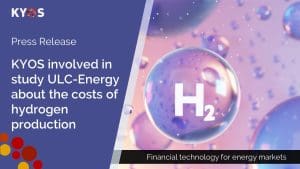KYOS involved in study ULC-Energy about the costs of hydrogen production
Press Release
KYOS involved in study ULC-Energy about the costs of hydrogen production
 This study analyses the costs of hydrogen production by a Rolls-Royce Small Modular Reactor (SMR) combined with Topsoe’s high temperature Solid Oxide Electrolyser Cell (SOEC) technology.
This study analyses the costs of hydrogen production by a Rolls-Royce Small Modular Reactor (SMR) combined with Topsoe’s high temperature Solid Oxide Electrolyser Cell (SOEC) technology.
The financial analysis of this study was supported by the advanced software models of KYOS Energy Consulting BV (KYOS). KYOS is a leading expert in the optimization and valuation of flexibility in energy markets. It has developed a unique software suite to assess revenue streams from various assets, including conventional gas, power, and renewable sources. The company has made significant strides in providing tools for valuing renewable energy assets, including wind and solar parks, PPAs, battery storage operations (BESS), hydrogen, and combinations thereof.
According to Steven Verbeek, Senior Consultant at KYOS: “It was a pleasure to work together with the ULC team to investigate the value of flexibility of ULC’s proposed configuration to produce affordable clean hydrogen. In a future where we need substantial and reliable volumes of hydrogen from non-fossil sources, and at the same time have to deal with a grid that is increasingly intermittent, the SMR+SOEC combination presents a compelling case, with substantial flexibility value.”
“Valuing flexibility in electricity markets requires sophisticated tools and expertise. It was a pleasure to work with KYOS and explore the strategic benefits of our proposed solution. Particularly KYOS’ professional team of experts and their willingness to go deep into detail was appreciated and we look forward to working together in future” said Dirk Rabelink, CEO of ULC-Energy.
The study revealed significant advantages of the SMR-SOEC combination:
- A Rolls-Royce SMR power plant can operate 24/7, with 95% availability
- ’SOEC electrolysis can produce more hydrogen per total power input when compared to conventional electrolyser technologies
- Steam can be supplied directly from the nuclear power plant heat exchangers
- H2 production can take place ‘off-grid’
The results revealed that hydrogen can be produced by the SMR – SOEC combination for less than €3.50/kg (2024€), significantly better than alternatives that lack the continuity and flexibility of nuclear energy. This cost can be driven down to less than €2.00/kg (2024€) by 2050 by taking into account the value of the flexibility to curtail hydrogen production and deliver electricity to an increasingly intermittent grid.
For more information, please refer to: Study reveals low cost of nuclear H2 | ULC Energy (ulc-energy.com)
